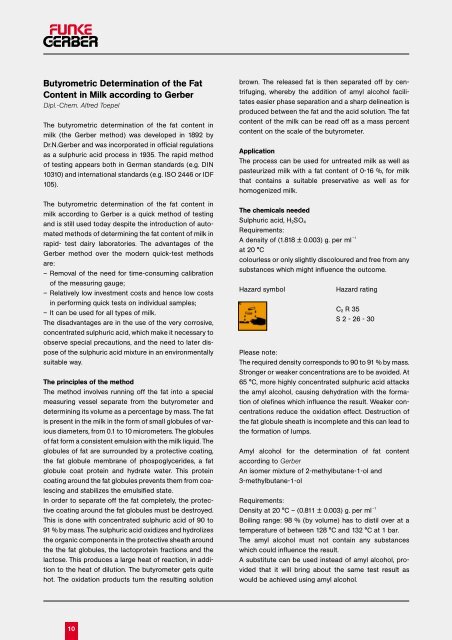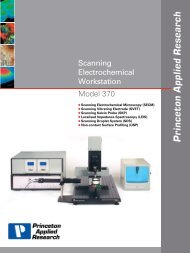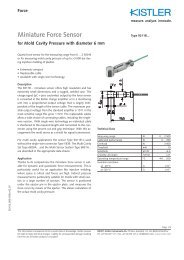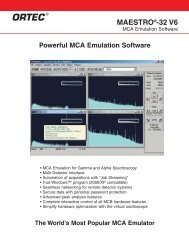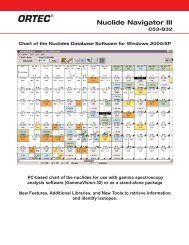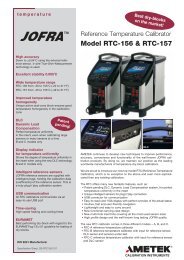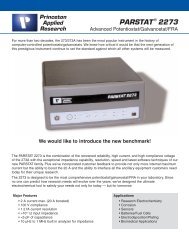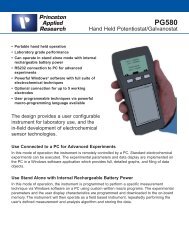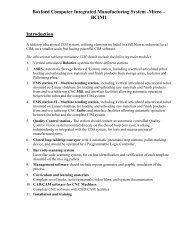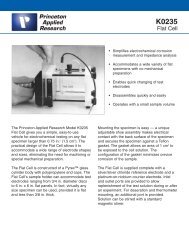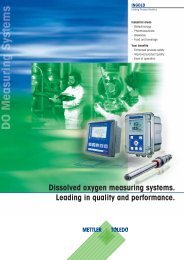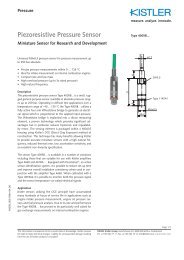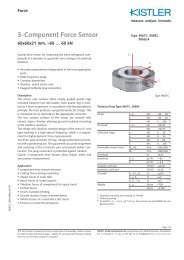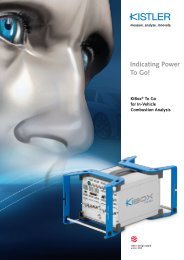Laboratory catalogue
Laboratory catalogue
Laboratory catalogue
Create successful ePaper yourself
Turn your PDF publications into a flip-book with our unique Google optimized e-Paper software.
Butyrometric Determination of the Fat<br />
Content in Milk according to Gerber<br />
Dipl.-Chem. Alfred Toepel<br />
The butyrometric determination of the fat content in<br />
milk (the Gerber method) was developed in 1892 by<br />
Dr.N.Gerber and was incorporated in official regulations<br />
as a sulphuric acid process in 1935. The rapid method<br />
of testing appears both in German standards (e.g. DIN<br />
10310) and international standards (e.g. ISO 2446 or IDF<br />
105).<br />
The butyrometric determination of the fat content in<br />
milk according to Gerber is a quick method of testing<br />
and is still used today despite the introduction of automated<br />
methods of determining the fat content of milk in<br />
rapid- test dairy laboratories. The advantages of the<br />
Gerber method over the modern quick-test methods<br />
are:<br />
– Removal of the need for time-consuming calibration<br />
of the measuring gauge;<br />
– Relatively low investment costs and hence low costs<br />
in performing quick tests on individual samples;<br />
– It can be used for all types of milk.<br />
The disadvantages are in the use of the very corrosive,<br />
concentrated sulphuric acid, which make it necessary to<br />
observe special precautions, and the need to later dispose<br />
of the sulphuric acid mixture in an environmentally<br />
suitable way.<br />
The principles of the method<br />
The method involves running off the fat into a special<br />
measuring vessel separate from the butyrometer and<br />
determining its volume as a percentage by mass. The fat<br />
is present in the milk in the form of small globules of various<br />
diameters, from 0.1 to 10 micrometers. The globules<br />
of fat form a consistent emulsion with the milk liquid. The<br />
globules of fat are surrounded by a protective coating,<br />
the fat globule membrane of phospoglycerides, a fat<br />
globule coat protein and hydrate water. This protein<br />
coating around the fat globules prevents them from coalescing<br />
and stabilizes the emulsified state.<br />
In order to separate off the fat completely, the protective<br />
coating around the fat globules must be destroyed.<br />
This is done with concentrated sulphuric acid of 90 to<br />
91 % by mass. The sulphuric acid oxidizes and hydrolizes<br />
the organic components in the protective sheath around<br />
the the fat globules, the lactoprotein fractions and the<br />
lactose. This produces a large heat of reaction, in addition<br />
to the heat of dilution. The butyrometer gets quite<br />
hot. The oxidation products turn the resulting solution<br />
brown. The released fat is then separated off by centrifuging,<br />
whereby the addition of amyl alcohol facilitates<br />
easier phase separation and a sharp delineation is<br />
produced between the fat and the acid solution. The fat<br />
content of the milk can be read off as a mass percent<br />
content on the scale of the butyrometer.<br />
Application<br />
The process can be used for untreated milk as well as<br />
pasteurized milk with a fat content of 0-16 %, for milk<br />
that contains a suitable preservative as well as for<br />
homogenized milk.<br />
The chemicals needed<br />
Sulphuric acid, H 2SO 4<br />
Requirements:<br />
A density of (1.818 ± 0.003) g. per ml –1<br />
at 20 °C<br />
colourless or only slightly discoloured and free from any<br />
substances which might influence the outcome.<br />
Hazard symbol<br />
Hazard rating<br />
C 2 R 35<br />
S 2 - 26 - 30<br />
Please note:<br />
The required density corresponds to 90 to 91 % by mass.<br />
Stronger or weaker concentrations are to be avoided. At<br />
65 °C, more highly concentrated sulphuric acid attacks<br />
the amyl alcohol, causing dehydration with the formation<br />
of olefines which influence the result. Weaker concentrations<br />
reduce the oxidation effect. Destruction of<br />
the fat globule sheath is incomplete and this can lead to<br />
the formation of lumps.<br />
Amyl alcohol for the determination of fat content<br />
according to Gerber<br />
An isomer mixture of 2-methylbutane-1-ol and<br />
3-methylbutane-1-ol<br />
Requirements:<br />
Density at 20 °C – (0.811 ± 0.003) g. per ml –1<br />
Boiling range: 98 % (by volume) has to distil over at a<br />
temperature of between 128 °C and 132 °C at 1 bar.<br />
The amyl alcohol must not contain any substances<br />
which could influence the result.<br />
A substitute can be used instead of amyl alcohol, provided<br />
that it will bring about the same test result as<br />
would be achieved using amyl alcohol.<br />
10


